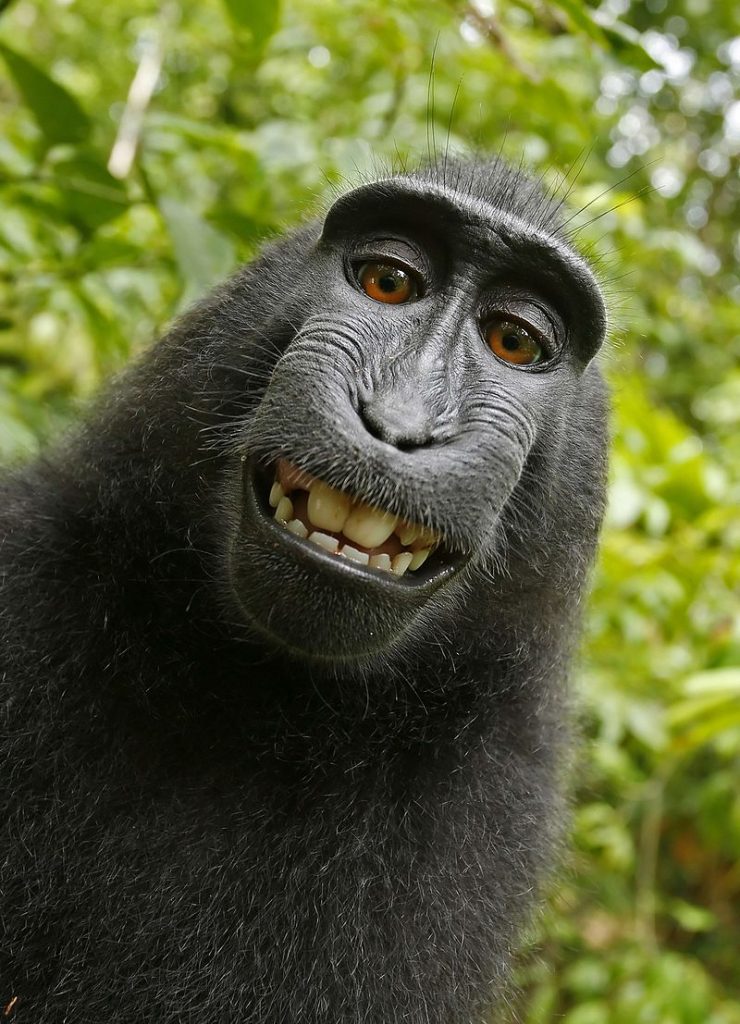What Happens When a Monkey Takes an Awesome Picture of Itself?

Pictured above is a monkey. Specifically, it’s a macaque, and one that is smiling– grinning, really — in a way that makes for a simply fantastic picture. Maybe not a Pulitzer winning one, but certainly one which is so good that the photographer is probably making a bunch of money from it.
He isn’t. In fact, he hasn’t seen a dime, at least not as of a few days ago. And the reason why? It boils down to one simple sentence: The monkey took the picture of itself. Yes, that picture is a monkey selfie.
And wow, did that cause some legal troubles.
The story starts in 2008, on the Indonesian island of Sulawesi. A photographer named David Slater set up camp in the forest, hoping to capture some of the indigenous wildlife on film. He befriended some wild macaques, shot some pictures, but was having difficulty getting close-ups of their faces; there were limits to how much the monkeys trusted him. That’s when he came up with an idea: what if he let the monkeys take the pictures, with him nowhere to be seen? He set up his equipment and, he’d later claim, he strategically placed the remote camera trigger in a place where the macaques could examine it and, hopefully, accidentally trigger it. And what we ended up with is the image above — taken by a macaque while it or a friend inspected the camera lens.
But: who owned that photo? Your first instinct may be to conclude that Slater holds the copyright to the photo; it was taken with his camera, according to his plan, and, in any event, he was the only person around. But fast forward to 2014, when the image made its way to Wikipedia. The Wikimedia Foundation — the organization behind Wikipedia — saw it differently, allowing the photo to be used on its sites without Slater’s permission. Here’s how Wikipedia itself summarizes their take: “The Wikimedia Foundation’s 2014 refusal to remove the pictures from its Wikimedia Commons image library was based on the understanding that copyright is held by the creator, that a non-human creator (not being a legal person) cannot hold copyright, and that the images are thus in the public domain.”
Slater disagreed, of course, but the US Copyright Office sided with Wikimedia. Slater told the BBC that the ruling and Wikimedia’s decision cost him “£10,000 or more in income” — he made about £2,000 before the pic hit Wikipedia, and virtually nothing afterward. And his troubles were about to get worse.
In September of 2015, PETA — the People for the Ethical Treatment of Animals — filed a lawsuit against Slater on behalf of the macaque who took the picture. They argued that Naruto — that’s the name PETA gave the monkey — having taken the picture, owned the copyright. The court sided with Slater but PETA appealed, and recently, the two sides settled. Of whatever (likely meager) amounts Slater earns from the photo going forward, 25% will be donated to organizations which protect the macaques’ habitat.
Naruto was unavailable for comment.
Bonus fact: Macaques aren’t only able to use cameras — they’re also able to use deer. Yes, deer, the animals. Macaques are known to hop on their backs, riding them like humans would use horses, as a mode of transportation. (Here’s a picture, for example.)
From the Archives: No Copying Grandma: Why some places won’t help you make copies of old family photos.
Related: “Wildlife Personalities” by David Slater. His collection of his photos, some taken by the monkeys themselves.
